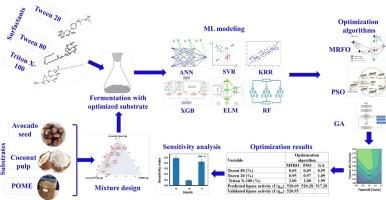Surfactant-facilitated metabolic induction enhances lipase production from an optimally formulated waste-derived substrate mix using Aspergillus niger: A case of machine learning modeling and metaheuristic optimization
Q1 Environmental Science
引用次数: 0
Abstract
This study introduces a novel method to enhance lipase production by integrating machine learning (ML) models and optimization algorithms. Six ML models, including support vector regression (SVR), kernel ridge regression (KRR), extreme gradient boosting (XGB), extreme learning machine (ELM), random forest (RF), and artificial neural networks (ANN), were employed to predict lipase activity in a multi-substrate system using avocado seed, coconut pulp, and palm oil mill effluent (POME) with Aspergillus niger. SVR proved the most effective (R2 = 0.9738; RMSE = 7.0089). Further optimization using manta ray foraging optimization (MFRO), particle swarm optimization (PSO), and genetic algorithm (GA) identified optimal substrate loadings, achieving a maximum lipase activity of 194.38 U/gds. The addition of a mixture of surfactants (Tween 80, Tween 20, Triton X-100) further increased lipase production to 520.95 U/gds (168.3 % increase). Global sensitivity analysis (GSA) confirmed the important roles of avocado seed, POME, and surfactants in enhancing lipase production. This approach represents a significant advancement in bioprocess scalability.

表面活性剂促进的新陈代谢诱导提高了利用黑曲霉从优化配制的废物衍生基质混合物中生产脂肪酶的能力:机器学习建模和元启发式优化案例
本研究介绍了一种通过整合机器学习(ML)模型和优化算法来提高脂肪酶产量的新方法。研究采用了六种机器学习模型,包括支持向量回归(SVR)、核岭回归(KRR)、极端梯度提升(XGB)、极端学习机(ELM)、随机森林(RF)和人工神经网络(ANN),来预测使用牛油果籽、椰子浆和棕榈油厂废水(POME)的黑曲霉多底物系统中的脂肪酶活性。SVR 被证明是最有效的(R2 = 0.9738;RMSE = 7.0089)。使用蝠鲼觅食优化法(MFRO)、粒子群优化法(PSO)和遗传算法(GA)进行进一步优化,确定了最佳底物负载量,实现了 194.38 U/gds 的最大脂肪酶活性。添加混合表面活性剂(Tween 80、Tween 20、Triton X-100)进一步提高了脂肪酶产量,达到 520.95 U/gds(增加 168.3%)。全球灵敏度分析(GSA)证实了鳄梨种子、POME 和表面活性剂在提高脂肪酶产量方面的重要作用。这种方法代表了生物工艺可扩展性的重大进步。
本文章由计算机程序翻译,如有差异,请以英文原文为准。
求助全文
约1分钟内获得全文
求助全文
来源期刊

Bioresource Technology Reports
Environmental Science-Environmental Engineering
CiteScore
7.20
自引率
0.00%
发文量
390
审稿时长
28 days
 求助内容:
求助内容: 应助结果提醒方式:
应助结果提醒方式:


